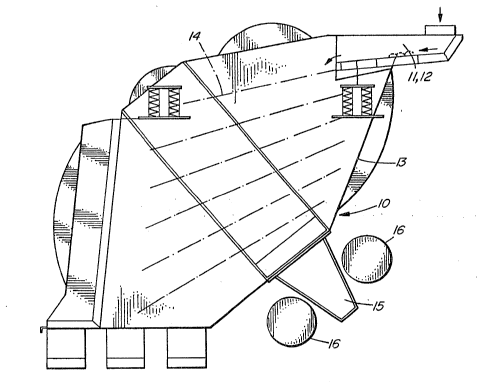Note : Les revendications sont présentées dans la langue officielle dans laquelle elles ont été soumises.
THE EMBODIMENTS OF THE INVENTION IN WHICH AN EXCLUSIVE
PROPERTY OR PRIVILEGE IS CLAIMED ARE DEFINED AS FOLLOWS:
1. A distributing and segregating device for a multideak
screening machine which includes a frame housing a plurality of
successive, superimposed screening decks, an inlet end through
which material to be screened can be fed onto an upstream end of
an upper deck, an outlet end having a plurality of outlets
associated with overflows or underflows of one or more succes-
sive ones of said screening decks, and at least one vibrator for
vibrating the frame, including said inlet end, for advancing
material received through said inlet end, across and through the
screening decks and to said outlets
said device comprising a module adapted to be
removably exchangeably supported on the frame of said multideck
screening machine for vibration therewith at said inlet end as a
means for feeding material to be screened into the multideck
screening machine through said inlet end, and including:
wall means defining an enclosed box having an upwardly
opening inlet and, transversally displaced from vertical
registry with said inlet, a forwardly and downwardly opening
outlet;
said wall means including a floor for said box, said
floor having a sloping, gabled, medially ridged upstream
portion disposed in vertical registry under said inlet and
sloping down towards a juncture with a sloping downstream
portion which is flatter by being less gabled and less medially
ridged than said upstream portion; said downstream portion
leading to said outlet at a downstream edge of said floor.
2. The distributing and segregating device of claim 1,
further including:
at least one distributing component mounted to said
wall means so as to have an elevated lower edge extending
transversally of said device at a location spaced above said
floor at a site disposed intermediate said inlet and said outlet
for encountering and adjusting excesses in height of material
being fed through said device to said multideck screening
machine.
-6-
3. The distributing and segregating device of claim 2,
wherein:
said lower edge of said distributing component is
serrated.
4. The distributing and segregating device of claim 2,
wherein:
said lower edge of said distributing component is
castellated.
5. The distributing and segregating device of claim 2,
further including:
at least two transversally neighboring deflectors
mounted to and disposed upon said downstream portion of said
floor for laterally deflecting material being fed over said
floor towards said outlet.
6. The distributing and segregating device of claim 5,
wherein:
said deflectors are movably mounted to said floor for
providing adjustable deflection of said material.
7. A distributing and segregating device for a multideck
screening machine which includes a frame housing a plurality of
successive, superimposed screening decks, an inlet end through
which material to be screened can be fed onto an upstream end of
an upper deck, an outlet end having a plurality of outlets
associated with overflows or underflows of one or more succes-
sive ones of said screening decks, and at least one vibrator for
vibrating the frame, including said inlet end, for advancing
material received through said inlet end, across and through the
screening decks and to said outlets
said device comprising a module adapted to be
removably exchangeably supported on the frame of said multideck
screening machine for vibration therewith at said inlet end as a
means for feeding material to be screened into the multideck
screening machine through said inlet end, and including:
wall means defining an enclosed box having an upwardly
opening inlet and, transversally displaced from vertical
registry with said inlet, a downwardly opening outlet;
said wall means including a floor for said box, said
-7-
floor being downwardly sloping, gabled, medially ridged, from
under said inlet to a downstream edge at said outlet;
said floor comprising two laterally adjacent flaps
which adjoin along a medial ridge; and
means for slope-adjustably mounting said flaps to said
box.
8. The distributing and segregating device of claim 7,
wherein:
as seen in top plan, said downstream edge of said
floor slants obliquely rearwardly in both lateral direction
from said medial ridge.
9. The distributing and segregating device of claim 8,
further including:
a respective weir-like guide member height-adjustably
secured to each said flap along said downstream edge of said
floor.
10. The distributing and segregating device of claim 7,
further including:
an upwardly domed element mounted between said wall
means in said box above said floor in vertical registry with
said inlet, so that material which is to be screened, upon being
introduced into said distributing and segregating device
through said inlet, encounters and is deflected by said domed
element before becoming supported on said floor.
11. The distributing and segregating device of claim 10,
wherein:
said domed element is disposed for deflecting some of
the material onto one of said flaps and some of the material
onto the other of said flaps.
-8-
